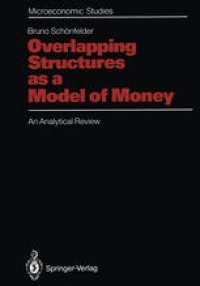
Ebook: Overlapping Structures as a Model of Money: An Analytical Review
Author: PD Dr. Bruno Schönfelder (auth.)
- Tags: Economics general
- Series: Microeconomic Studies
- Year: 1992
- Publisher: Springer-Verlag Berlin Heidelberg
- Edition: 1
- Language: English
- pdf
The list of those to whom I am indebted is a long one. Prof. Neil Wallace (University of Minnesota) stimulated my interest in the kind of models with which the book deals. I am grateful for a large number of conversations with him. I learned a lot from him and will always be proud that I have been one of his student. I hope that he is not dissappointed with the outcome. I am deeply indebted to Prof. Dr. Hans-Werner Sinn (University of Munich). His observations and critical remarks were instrumental for a great number of changes and improvements which I was able to introduce while revising the manuscript again and again, and rethinking the basic arguments. I also want to thank Prof. Dr. Utta Gruber (University of Munich) for her helpful comments and for her support. I am very much obliged to Prof. Dr. Dr. h. c. Hans Moller (University of Munich). For many years I have had the honour of a nearly continuous dialogue with him. I am also grateful to Prof. Dr. Werner Gumpel (University). The stimulating atmosphere and the research opportunities which were provided by his seminar contributed a lot to my work. Finally I want to thank my wife Sigrid for looking through the English draft of this book and correcting numerous linguistic flaws. The remaining errors are of course mine. CONTENTS Page v Preface 1. INTRODUCTION 1. 1.
The book reviews monetary applications of overlapping gene- rations models and models with cash-in-advance constraints. It focuses on the implications for monetary economics. It tries to make sense of the available indeterminancy propositions. They are the most puzzling property of OGMs. The book surveys and synthesizes most of the available research papers. Assesses the usefulness of the approach for the advancement of monetary economics. The book can be used as a non-technical introductory text, which relies foremost on intuitive arguments.